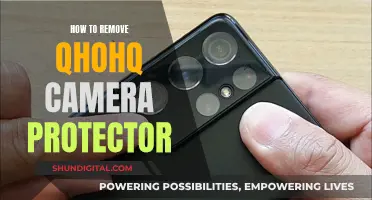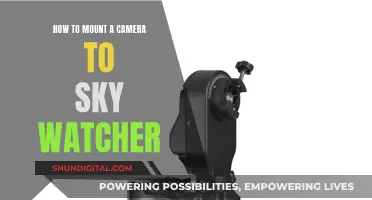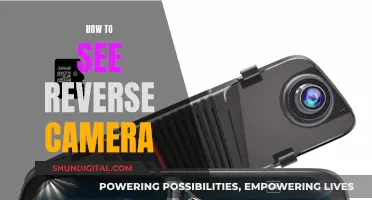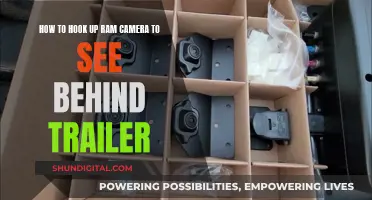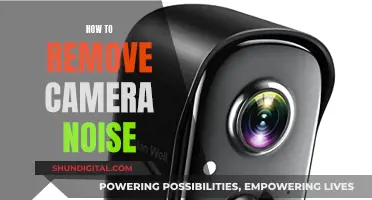
Watching golf on television has changed significantly over the years, with technology now providing viewers with a more immersive and insightful experience. One of the most notable advancements is the ability to track golf balls using technology like TopTracer, which was originally called ProTracer until it was rebranded in 2016. This technology uses CMOS sensors in cameras to follow and track the ball in flight, providing real-time data and graphics on its flight path, speed, curve, and more. In addition to TopTracer, skilled camera operators also play a crucial role in capturing the action, requiring a good understanding of the game and quick reflexes to follow the ball and choose the best camera angles.
| Characteristics | Values |
|---|---|
| Technology | Toptracer (originally Protracer) |
| Camera Type | Stationary |
| Camera Placement | Behind the golfer, in trees, towers, blimps, or on the course |
| Camera Sensors | CMOS (Complementary Metal-Oxide Semiconductor) |
| Data Conversion | Sensors convert data into flight graphics |
| Data Analysis | Ball speed, apex, curve, carry, clubhead speed, launch angle, ball spin |
| Company | Topgolf |
| Founder | Daniel Forsgren |
| Year Founded | 1998 |
| Use Case | TV broadcasts, coaching, club fitting, driving ranges |
What You'll Learn

TopTracer technology
TopTracer is a ball-tracing technology that uses a special camera to track the entire flight of a golf ball. It then adds a trace graphic to the screen, allowing viewers to see the path of the ball. This has transformed the golf viewing experience, as previously, the ball could sometimes be hard to see against white clouds or bright skies. TopTracer can be used to track shots from anywhere on the course, including key approach shots during pivotal moments in a tournament.
The technology also provides real-time shot analytics, such as ball speed, apex, curve, carry, and more. This data can be integrated into virtual course graphics to animate the ball's trajectory in a side-slab format.
TopTracer is trusted by major networks such as NBC, CBS, Golf Channel, and Sky Sports, and is used to trace the shots of the game's best players at hundreds of tournaments each year.
Lane Watch Camera: When Did Honda Introduce This Feature?
You may want to see also

CMOS sensors
CMOS stands for Complementary Metal-Oxide Semiconductor. CMOS sensors are used in modern DSLR cameras and are the technology behind Toptracer (formerly Protracer), which is used to track golf balls on TV.
Toptracer uses CMOS sensors in special cameras to follow and track the ball in flight and convert that data into the flight graphics that viewers see on their screens. The CMOS sensors create a 3D space, and when a golf ball travels through that space, the sensors track it in real time.
The CMOS sensors are linked to a computer, which identifies the ball in each image and creates a real-time tracking image of the flight path. This data is then delivered to TV screens, providing viewers with immersive graphics of the ball's trajectory.
Toptracer's stationary camera is usually positioned behind the golfer to optimise data capture. However, the system is designed to be mobile, allowing the camera to be moved to different locations on the course to provide additional graphics and data for players, commentators, and viewers.
The technology has evolved to include new features, such as tracking and analysing ball spin, clubhead speed, launch angle, and more. These advancements have not only enhanced the viewing experience but also provided valuable insights for players and commentators.
Accessing Tesla's Cameras: A Step-by-Step Guide
You may want to see also

Human camerawork
Following a golf ball as it flies through the air is no easy task for a camera operator. It requires a good understanding of the sport, quick reflexes, and a lot of practice. Even with experienced camera operators, it is still possible to lose sight of the ball, especially if it takes an unexpected trajectory.
To aid camera operators in following the ball, gyro-stabilized cameras are often used, and camera positions are carefully chosen to give the best chance of keeping the ball in frame. Camera operators will often start with a fairly wide shot and then zoom in on the ball as it arcs through the air. They may also stay on the golfer for a second or two after they hit the ball, rather than immediately following its trajectory, to wait for the perfect moment to put the shot live on air.
While technology has now taken over much of the work in tracking golf balls for TV, human camerawork still plays an important role in golf broadcasting. The choice of camera shot and angle can add tension and tell a story in a way that ball-tracking technology cannot.
Watching DV Camera Footage on Windows 10
You may want to see also

Gyro-stabilized cameras
Gyro-stabilized systems provide a stable platform for broadcasting live sports and news events, as well as for film and television production. They can be mounted on masts, towers, trees, and blimps, or used handheld to capture smooth shots during fast-paced scenes. For example, in the chase scene through the forest in "Return of the Jedi," a gyro-stabilized camera was used to capture an ultra-smooth shot while the cameraman walked or ran, which was then sped up to create the illusion of a fast and intense chase.
In the context of golf, gyro-stabilized cameras can be used to track the flight of a golf ball, providing stable and clear footage for viewers at home. This technology, combined with strategic camera placement and advanced software, has revolutionized the viewing experience for golf fans, allowing them to see the incredible feats of professional golfers in a whole new way.
Hotel Cameras: Privacy or Security?
You may want to see also

Tracking cameras
Camera Placement and Operation:
The positioning of cameras plays a crucial role in effectively tracking golf balls. Cameras are often placed in elevated locations, such as towers, trees, or blimps, to capture the flight of the ball from different angles. Camera operators with a deep understanding of the game and years of experience can anticipate the trajectory of the ball and adjust their shots accordingly. The skill and intuition of these operators contribute to the tense and dynamic shots viewers experience during a broadcast.
Technology:
In recent years, the introduction of advanced technology has revolutionized golf broadcasting. Toptracer (formerly known as Protracer) is a prominent example of this innovation. Toptracer utilizes CMOS sensors, similar to those found in modern DSLR cameras, to create a 3D space. When the golf ball travels through this space, the sensors track its movement in real time. This data is then processed by a computer, which identifies the ball in each image and generates a tracking image of the flight path for viewers to see.
Toptracer has been adopted by major television networks, including NBC, CBS, and the Golf Channel, elevating the viewing experience for golf enthusiasts. The technology provides valuable insights into various aspects of the game, such as ball speed, apex, curve, and carry. It also enables real-time shot analytics, including clubhead speed, launch angle, and ball spin, benefiting both players and commentators.
The combination of skilled camera operation and cutting-edge technology has transformed how golf is captured and presented on television, offering viewers a more engaging and informative perspective on the game.
TCL 55-Inch TV: Camera-Equipped or Not?
You may want to see also
Frequently asked questions
TV cameras follow golf balls with the help of a technology called TopTracer, which uses CMOS sensors in cameras to track the ball in flight and convert that data into the graphics you see on your TV.
TopTracer uses complementary metal-oxide semiconductor (CMOS) sensors, installed in a camera, to monitor the golf ball. The cameras create a 3D space, and when a golf ball moves into that space, it’s tracked by the sensors.
TopTracer provides a more immersive viewing experience for golf fans, allowing them to see the ball flight of players' shots and understand their strategy. It also provides valuable data and insights for players, commentators, and viewers, such as ball speed, apex, curve, carry, and more.


